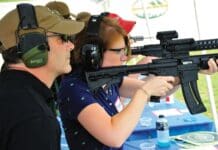The press release for Advanced Ballistics Concepts‘ (ABC) new Triple Threat Technology (T3) round claims that “more than 90 percent of shots fired by handguns and hand-held firearms miss their targets.” Judging from my experience at the gun range, I assume they’re referring to bullets fired in self-defense situations. If so, that’s a scary ass stat. Personally, I would have thought that teaching shooters to concentrate a bit more in the aiming department and less in the shooting department would be the best solution to that particular problem. Apparently, not . . .
The T3’s “the first multi-part bullet that immediately unlocks and expands to a predetermined diameter and pattern of spread upon leaving the tip of a rifled barrel.” Kinda like the shotshell coming out of the Taurus Judge, only just three pieces and the pattern stays within a specified parameter.
Yup. Here’s some bumph from their website:
Once deployed, the segments of our proprietary Wide Envelopment Bullet™ (W.E.B™) are tethered together (like a spider web), to offer the shooter a much wider impact zone, reducing the occurrence of missed shots and thereby reducing the risk of collateral damage. (A standard .45 cal slug is .452 inches in diameter and remains that way until it collides with something, where as a T3™ round of the same caliber can be made to expand (instantly upon leaving the barrel) to a predetermined diameter (range 6 “ to 16 “ or greater) . . .
T3 bullets are similar to multi-pellet buckshot in that both deliver multiple strike points. However, a T3 round enhances performance because the bullet expands up to 4x faster than buckshot. The bullet design also allows each segment to have a greater mass which in turn produces greater stopping power.
Back to the presser:
T3 is the first bullet to interconnect three separate segments with Kevlar strings that expand like a spider web to a predetermined diameter and spread pattern that not only dramatically improves the accuracy and hit probability, but does so without disrupting the normal flight path of a spinning bullet. T3 bullets employ a proprietary “accelerated radial spread” that compensates for most, if not all, of typical shooter error. . .
Because every T3 bullet offers a wide shot profile, it compensates for marksman’s error which significantly increases hit probability.
H-h-h-h-h-old it. Correct if I’m wrong (perish the thought), but doesn’t expanding the diameter of the area where the bullet—now bullets—will hit increase the chances of a catastrophic miss. In other words, if there’s someone standing next to your intended target and you somehow manage not to aim at center mass (perish the bad guy), you stand a great chance of hitting the innocent person. Indeed, if you miss the BG entirely, there’s a wider area of missinghoodness.
Hmmm. I wonder what those Kevlar strings do in terms of a wound profile. Do they separate when the bullets hit the target or is this thing a flying cheese grater? Meanwhile, shooters need not worry overmuch about over-penetration
“No one wants to cause collateral damage when discharging a firearm, particularly in the confusion of a threatening situation,” said [ABC Co-Founder and President Todd] Kuchman. “That’s why the T3 bullet is the first to offer SMART-STOP™ technology, a proprietary braking system that can be configured to stop the bullet after hitting a typical household wall or live target.”
Howzzat then? The presser is unenlightening. Anyway, ABC is preparing to offer its T3 bullets in three categories: non-lethal (T3 Stinger), semi-lethal (T3 Stunner) and fully-lethal (T3 Stopper). Semi-lethal? Is that the opposite of being a little pregnant?
By offering the three variants, ABC supports the blended use of T3 bullets (Smart-Stack) which eliminates the need for additional expensive weapons – such as shotguns – and Tasers that military and police typically have to carry to address varied threats.
How could that possibly go wrong? Answers below. Still, despite my snark, I’m anxious to see this new round in action. No arachnophobe I.




I’LL TAKE ONE CASE OF EACH PLEASE.
Threat #1: one might actually shoot the bad guy
Threat #2: one might accidentally shoot anyone or even everyone near the bad guy
Threat #3: one might go bankrupt by purchasing these things
Personally, I would have thought that teaching shooters to concentrate a bit more in the aiming department and less in the shooting department would be the best solution to that particular problem.
The “Training” mantra is all well and good, but shooting on a square range, on a lovely afternoon (or even a snowy one) tends not to prepare folks for the reality of a fight/flight adrenaline dump coursing through their veins when the fecal matter hits the proverbial air moving device.
Think of this- Pat Rodgers (a former Marine and one deeply involved with USMC SOCOM training and equipment procurement) once stated that the goal of training with small targets was to overcome the fact that shooting accuracy degrades by AT LEAST 50% in actual combat. That is amongst folks who practice with weapons hours per day, have a significant force-on-force training budget, have been subjected to serious stress inoculation events, are in peek physical condition and many of them have already experienced combat.
Is it any wonder that police officers have something like an average 20% hit ratio on the bad guy? Even though most police firearm training is appalling, it is still better training than the vast majority of civilian firearms owners go through.
There are ways to mitigate the effects of adrenaline; competition shooting under time pressure and force-on-force training with Simunitions or something similar. The number of civilians or police participating in this kind of shooting is extremely low.
“[P]olice officers have something like an average 20% hit ratio on the bad guy.”
True, but their hit ratio is 100% on guys with “watering devices,” cell phones, combs and wheelchairs.
“H-h-h-h-h-old it. Correct if I’m wrong (perish the thought), but doesn’t expanding the diameter of the area where the bullet—now bullets—will hit increase the chances of a catastrophic miss. In other words, if there’s someone standing next to your intended target and you somehow manage not to aim at center mass (perish the bad guy), you stand a great chance of hitting the innocent person. Indeed, if you miss the BG entirely, there’s a wider area of missinghoodness.”
This was my first thought. If a shooter normally capable of shooting a 8-inch group, expands by 50% (according to Pat Rogers-a well-respected, non-insane source) that brings the group to 12 inches. Now add 6 or even 16 inches of grouping by the ammo. So a 8-inch group is now up to 28 inches. Considering the average width of center mass of a body is far smaller, I would say that may be a recipe for disaster.
After reading the Rabbi’s explanation I won’t be ordering any of this ammo. I’ll stick to my regular old ammo and practice a lot, which is more fun anyway.
I also wonder what the terminal ballistics of this ammunition are like.
Handgun calibers are all very poor fight enders against people with a lot of will and/or freelance pharmaceutical help. This is true even of the biggest, baddest .45 ammo. Where you make hits counts, but you need at least 8″ of penetration to even begin making dents in mission critical systems to shut an attacker down.
Once your 9mm round (already anemic in the mass department with all the gubbins inside) splits into 3 shell sections with some kevlar string; how much mass will they have? How will that mass effectively penetrate at least 8″ into a bad guy?
If two rounds miss and one hits, will the two rounds pull the one round out of the body with their string???
It really all depends on the strength and elasticity of the tethers. If the tethers have some stretch and are strong enough not to break, the one hit would likely wrap the other two projo-pieces into the target. After all, human tissue is quite a bit more viscous than air.
I wonder what happens when the badguy starts shooting at you from behind a chainlink fence?
Comments are closed.